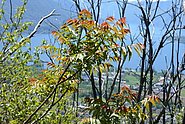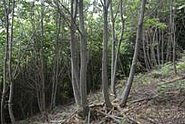Forests are exposed to human-induced and natural disturbances generating opportunities for new species to establish, including non-native woody species. Understanding how disturbance characteristics interact with the site context and invasive species traits to drive invasion processes is crucial for designing sustainable forest management. Here, we use the case study of the deciduous broadleaved forest belt of Canton Ticino (Switzerland) to identify the main factors determining the presence of non-native invasive woody species in recently disturbed forests. We identified and selected 851 forest gaps caused by natural, silvicultural or other anthropogenic disturbances between 2008 and 2015. For each gap, the presence of non-native invasive woody species as well as the characteristics of the corresponding landscape, site, and the gap itself were determined. For the six most frequent non-native invasive woody species, we identified the parameters that influenced their presence by means of modelling approach. The resulting variable coefficients were then used to create maps of colonisation risk. Among the six target species (i.e., Ailanthus altissima, Buddleja davidii, Robinia pseudoacacia, Paulownia tomentosa, Prunus laurocerasus, and Trachycarpus fortunei), the factors influencing their presence were either shared (e.g., distance to the next colonisation hotspot), partially shared (e.g., distance to buildings, altitude, aspect), or completely species-dependent (e.g., topography, slope, distance to powerlines). Like in other mountainous areas, non-native invasive woody species concentrate at low altitudes and near densely populated areas where hotspots of seed-bearing individuals can be found. Moreover, different life-history groups (i.e., wind-dispersed pioneer species vs. animals-dispersed evergreens) shared specific invasion patterns characteristics. In addition to general management strategies, we argue that more species-specific strategies should be adopted to prevent the colonisation by non-native invasive woody species. In this context, the consideration of seed-bearing individual hotspots should be given highest priority, followed by the type and the characteristics of the disturbance.
Siehe DOISiehe Institutional Repository DORA


